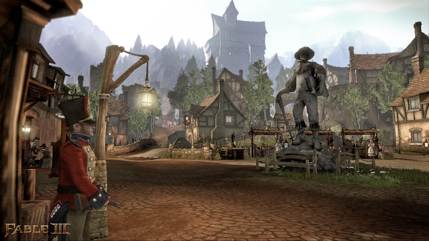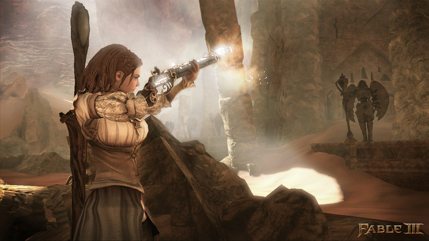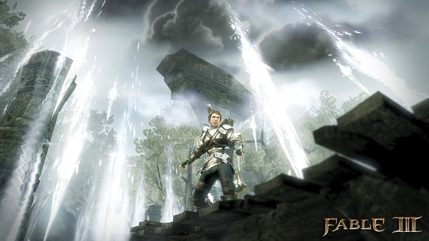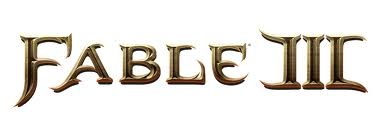“Under-promise and over-deliver.”
It’s an old, faithful nugget of wisdom passed down for generations. It’s also a memo sadly forgotten (or never received in the first place) by Peter Molyneux, Creative Director at Lionhead Studios and creator of the Fable franchise. With each new iteration in its short but storied history, Fable has promised to move Heaven and Earth in its effort to revolutionize the RPG genre.
Unfortunately, each iteration seems to be a generation behind what’s promised. The original Fable (Xbox) was a good game, but was missing many of the major player-influenced features that were originally promised. Fable II (Xbox 360) was a big improvement, but only brought the series to near-par with the promises made for the first iteration. The hype was huge, but neither of Molyneux’s babies could live up to the promises made by their father. Unlike those two games, Fable III’s pre-release hype and marketing campaign was nearly silent, to the point where I knew little of what to expect from the third installment. The only promise? That we’d finally get to rule Albion as king (or, in the case of my heroine, queen). Maybe, just maybe, Molyneux, Lionhead Stuidos and Microsoft were finally taking that little anecdote to heart and hoping to wow gamers by promising little, but delivering greatly.
Or, maybe not.

Let’s get straight to the point. I’ve played Fable III for about five hours now. I’ve done a dozen quests. I’ve killed a few hundred enemies. I’ve “leveled up” a few times. I’m also pained to admit that, on first blush, Fable III is hardly a leap in regards to quality and features. In fact, in many ways, the series regresses as much as it progresses.
Unlike the first two games, you no longer begin the game as a child. This time around there’s no illusion that you’re guiding a hero through his or her entire life. Instead, the game cuts right to the chase—you’re the son or daughter of Fable II’s hero and, whether you like it or not, you’re placed in direct opposition to your ruthless brother. Want to join him in ruling the land with an iron fist? Sorry, not gonna happen. For a series that originally promised to give the player a hand in guiding every action and decision in the game, Fable III is a shockingly linear and guided experience. You move from plot-point to plot-point, deviating into side-quests if you choose, but always working towards the common goal of dethroning your evil older brother. (A plot that fans of fantasy should recognize immediately.)
With games like Fallout 3 or The Elder Scrolls: Oblivion on the market (or even older games like Planescape: Torment and Neverwinter Nights being made available again via digital release), it’s not hard to find games that offer true game-changing repercussions to a player’s decision, it seems odd for Fable III to be streamlining itself and straying so far from the roots of its predecessors, rather than embracing what made the series so successful in the first place. For instance, just before sitting down to write this I accepted a quest to kill some bandits who were terrorizing a nearby town. I trekked over to their camp, snuck in with a disguise but was eventually forced to kill them all and fight their leader. Upon his defeat, I was given the choice whether to kill or spare him, but where was the choice to side with the bandits? To take a cut of their profits and run my own little racketeering ring? Can’t I sneak into the camp and assassinate the leader without being seen? Why not stroll in like I was the cock-of-the-block and parley my way around the solution? In Fable my hero grew fuckin’ demon horns from his skull. In Fable III, it seems a halo is almost inevitable.

Similarly, character development, one of the true delights of Fable and Fable II, seems dumbed-down by the Road to Rule. No longer do you accrue experience based on your actions. Rather, your skills are acquired by experience gained from battle and interacting with the citizens of Albion. And branching paths? Forget about it. I’ve managed to open every chest presented to me. Use a lot of guns and barely use your sword? Doesn’t matter, you’ll still unlock melee upgrades at the same rate as ranged upgrades. Character progression’s been completed neutered and homogenized and as a result I feel detached from my heroine, a major letdown after the bond I formed with my heroine in Fable II. My fingers are crossed that this will change as I delve deeper into the game, but with fifty-percent of the chests open, I won’t hold my breath.
The big kicker is that the game uses the Road to Rule to limit your abilities within the game world. Saved up some money and want to buy a wagon? Or maybe you want to get married? Nope, not until the game lets you open the applicable chest on the Road to Rule. Want to dye your clothes pink? Oops, you’ve only unlocked red, blue, grey and green dyes. What do you mean I can’t fart at anyone? That was a staple of social interaction in the earlier games! Oh, I have to wait until I can unlock the next chest? Bah! Bollocks.
The game lacks a traditional menu, which has been a divisive feature with most gamers. Instead of choosing from a text-based list of options, pressing start whisks you away to The Sanctuary, a small hub-style building with several rooms, one each devoted to wardrobe, weapons, trophies and online. With only five hours under my belt, I don’t mind the system. It’s no slower than the sluggish menu in Fable II and the visual representation of your achievements (like a pile of gold and treasure that gets larger as you acquire more money or mannequins wearing your different costumes) is a nice treat. Sure, I might be sick of it after 20 hours, but for now its a non-issue. Lack of a useable mini-map, however, is an issue.
The world of Albion has progressed to a post-industrial era, which gives the set-pieces a nice steampunk-esque atmosphere. Political propaganda posters litter the ground and wallpaper buildings, steam-powered monorails travel across the kingdom, factories spew smog through the major cities, and a revolution brews in the lower social circles. It’s a lovingly detailed world, but (and here come my Fable II-branded rose-tinted glasses), it doesn’t feel quite as tightly conceived as Fable II’s version of Albion. I have such fond memories of running through the first outdoor setting in Fable II, diving from high up on a spire found in the centre of a crystalline lake, hunting the forest for treasures and silver keys, running at sunset with my dog at my side. In comparison, Fable III lacks that final pass of polish and attention to detail. The world’s larger, but the result is that everything’s further apart, but there’s less to see along the way. Still, with each passing hour, Albion’s grown on me, and I wouldn’t be terribly surprised if I end up looking back on Fable III’s world as fondly as I do Fable II’s, if for different reasons.

Graphically, it’s a mixed bag. The art direction’s great, as can be expected from Lionhead Studios, but the graphics are rough around the edges on a technical level. Slowdown happens seemingly at random, bogging the game down to slideshow speeds, seams appear in hillsides and heat-waves from a fire turn everything behind them into a pixelated mess. Nostalgia might be talking here, but I was surprised to find that Fable III looks worse than its two-year-old predecessor.
Combat’s another area that sees little-to-no progression, if not downright regression from the previous game. It’s slow, the enemies just stand about waiting for me to attack them, and I never feel quite as in control as I should. As I gain more magical powers and better weapons, I hope the fluidity and rhythm of battle kicks up a notch. It’s a shame, because the three-button system the series uses (one button each for melee, ranged, and magic attacks) shows promise, but it’s just too shallow and technically shaky to really set itself apart.
Despite the sky-high expectations heaped upon it, Fable II blew me away and remains one of my favourite gaming experiences in this generation of consoles. Fable III, on the other hand, seems to be playing catch-up, regardless of my almost non-existent expectations. Despite reservations, I’ve been enjoying my experience with the game, but I’m far from being as enamoured with it as I was with the earlier games. The big conceit of the game is your ability to rule Albion as regent, and I’ve not yet reached that stage. Will it change my mind and wipe away some of the disappointment? I don’t know, but I’m enjoying myself just enough to find out.
Aidan Moher is the editor of A Dribble of Ink, a humble little blog that exists in some dusty corner of the web. He hasn’t won any awards, or published any novels. But he’s, uhh… working on that.
He is also a contributor at SF Signal and the lackey for io9’s Geek’s Guide to the Galaxy podcast.










